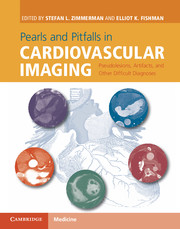 Pearls and Pitfalls in Cardiovascular Imaging
Pearls and Pitfalls in Cardiovascular Imaging from Section 9 - Mesenteric vascular
Published online by Cambridge University Press: 05 June 2015
Imaging description
Small nodular hepatic early enhancing areas on multiphasic contrast-enhanced CT or MRI imaging can mimic malignant pathology. These early enhancing lesions are typically located in the periphery of the liver, measure only a few millimeters and are visible predominantly on the arterial phase of contrast imaging fading to isodensity/intensity on the delayed-phase imaging (Figures 74.1 and 74.2). Importantly, these lesions do not have a corresponding abnormality on the non-contrast T1- and T2-weighted MR imaging (Figure 74.3 and 74.4) and do not demonstrate restricted diffusion on diffusion-weighted imaging.
Importance
An arterioportal shunt occurs as result of a direct connection between the hepatic arterial and the portal venous systems and is an important cause of transient hepatic attenuation/intensity difference (THAD/THID). This tends to occur in the presence of diminished portal venous flow as in the case of cirrhosis or due to external factors such as trauma or percutaneous intervention. These pseudolesions have to be differentiated from malignant ones to avoid unwarranted anxiety in patients and to avoid invasive testing such as biopsy or even surgical resection.
Typical clinical scenario
These lesions may be a source of concern in patients with cirrhosis or a known malignancy with hypervascular metastasis such as renal cell carcinoma or neuroendocrine tumors. Due to their small size biopsy is usually not an option and these lesions tend to disappear or remain stable on the follow- up examinations (Figure 74.5).
Differential diagnosis
A small flash-filling hemangioma is typically very bright on T2- weighted MR imaging and typically retains contrast on the more delayed-phase imaging. Hepatocellular carcinoma and even metastatic disease from cancers like renal cell, melanoma or neuroendocrine tumors tend to washout on the venous and delayed-phase imaging and appear as lower density/intensity than the liver. The absence of washout on delayed imaging, peripheral location, small size, and absence of abnormality on T1-, T2- and diffusion-weighted imaging along with long-term stability are features of a benign process such as an arterioportal shunt.
To save this book to your Kindle, first ensure no-reply@cambridge.org is added to your Approved Personal Document E-mail List under your Personal Document Settings on the Manage Your Content and Devices page of your Amazon account. Then enter the ‘name’ part of your Kindle email address below. Find out more about saving to your Kindle.
Note you can select to save to either the @free.kindle.com or @kindle.com variations. ‘@free.kindle.com’ emails are free but can only be saved to your device when it is connected to wi-fi. ‘@kindle.com’ emails can be delivered even when you are not connected to wi-fi, but note that service fees apply.
Find out more about the Kindle Personal Document Service.
To save content items to your account, please confirm that you agree to abide by our usage policies. If this is the first time you use this feature, you will be asked to authorise Cambridge Core to connect with your account. Find out more about saving content to Dropbox.
To save content items to your account, please confirm that you agree to abide by our usage policies. If this is the first time you use this feature, you will be asked to authorise Cambridge Core to connect with your account. Find out more about saving content to Google Drive.